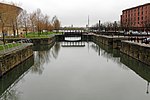John Lennon Peace Monument
Buildings and structures completed in 2010Buildings and structures in LiverpoolEngvarB from September 2014Monuments and memorials in LiverpoolMonuments and memorials to John Lennon ... and 1 more
Peace monuments and memorials

The John Lennon Peace Monument, also known as the European Peace Monument, is a peace monument entitled Peace & Harmony in Liverpool, England, dedicated to the memory of John Lennon. Peace & Harmony was unveiled by Julian and Cynthia Lennon at a ceremony in Chavasse Park, Liverpool, on Saturday 9 October 2010 to celebrate what would have been John Lennon's 70th birthday. The monument is now on the waterfront adjacent to ACC Liverpool at Kings Dock.
Excerpt from the Wikipedia article John Lennon Peace Monument (License: CC BY-SA 3.0, Authors, Images).John Lennon Peace Monument
Kings Parade, Liverpool Baltic Triangle
Geographical coordinates (GPS) Address Nearby Places Show on map
Geographical coordinates (GPS)
| Latitude | Longitude |
|---|---|
| N 53.396666666667 ° | E -2.9909583333333 ° |
Address
BT Convention Centre
Kings Parade
L3 4FP Liverpool, Baltic Triangle
England, United Kingdom
Open on Google Maps







